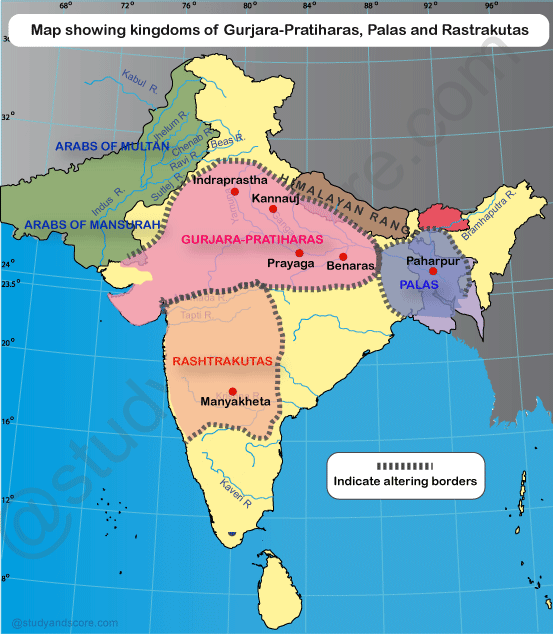Kannauj located in the central Gangetic valley was a very important center for trade and commerce. Hence obviously all the dominant dynasties of the time fought for power and control over this area. The dominant dynasties of this time were Gurjara-Pratiharas, Palas and Rashtrakutas. Historians often describe this fight between the three dominant dynasties of 8th century as the tripartite struggle.
Palas ruled the eastern parts of India and Pratiharas dominated western India and Rashtrakutas controlled Deccan regions of India. The tripartite struggle ultimately ended in favor of Nagabhata II, Gurjara –Pratihara ruler.
Kannauj was the erstwhile capital of Harshavardhana Empire in North India. The following were the causes which provoked tripartite struggle,
The Pratihara ruler named Vatsaraja was very ambitious about Kannauj. Similarly Dharmapala, the Pala ruler also wanted to rule over Kannauj. And thus these two rulers were into a conflict. Vatsaraja defeated Dharmapala in a battle at Gangetic Doab. And at the same time Vatsaraja was defeated by the Rashtrakuta king Dhruva. Dhruva also defeated Dharmapala. Finally this pronounced enmity led to Tripartite Struggle between Palas, Rashtrakutas and Pratiharas.

After the attack by Dhruva, Dharmapala could manage to get back control over his territory and placed Chakrayudha on the throne of Kannauj. But soon Nagabhata II, the successor of Pratihara ruler Vatsaraja conquered Kannauj and drove away Chakrayudha. Later Nagabhata II also defeated Dharmapala.
The struggle for Kannauj became more severe after the Nagabhata II exercised control over it. During the rule of Rashtrakuta ruler Krishna III, there was successful campaign against the Cholas. The Rashtrakutas also formed a matrimonial relationship with other feudal kings. However, by the end of the 9th Century the power of the Rashtrakutas started to decline along with the Palas. And by the end of the tripartite struggle, the Pratiharas emerged victorious and established themselves as the rulers of central India.
- Share with your friends! -
Login to post your comment here...
- or with social Account -